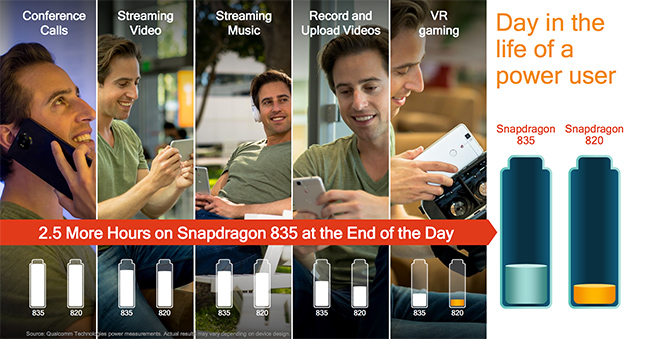The Qualcomm Snapdragon 835 Performance Preview
by Matt Humrick & Ryan Smith on March 22, 2017 4:30 AM EST- Posted in
- Smartphones
- Snapdragon
- Qualcomm
- Mobile
- SoCs
- Snapdragon 835
- Kryo
First Thoughts
Mobile SoCs are packed with specialized processors: CPU, GPU, high-performance DSP (compute), low-power DSP (sensor hub), modem DSP (signal processing), ISP (image processing), fixed-function blocks (video, audio), etc. And while all of these pieces contribute to the overall user experience, some of them are difficult to quantify. The CPU and GPU remain vital to device performance and battery life, so it’s still important to probe their capabilities.
Our initial testing shows that Snapdragon 835’s Kryo 280 CPU is an octa-core, big.LITTLE configuration with four semi-custom A73 “performance” cores and four semi-custom A53 “efficiency” cores. Kryo 280’s performance cores are pretty much equivalent to Kirin 960’s A73 cores in both integer and floating-point IPC, but comparing them to Snapdragon 820’s Kryo CPU shows mixed results: integer IPC improves but floating-point regresses.
In our limited system testing, the Snapdragon 835’s IPC gains outweigh its losses, providing better overall performance than the Snapdragon 820/821 phones. Unsurprisingly, the Snapdragon 835 MDP/S matched the performance of the Mate 9’s Kirin 960, which may not sound all that exciting, but considering our positive experience with the Mate 9, it’s certainly not bad either.
Qualcomm continues to push hard into VR/AR, not just with smartphones but stand-alone HMDs too. The high resolution and low latency requirements for these experiences suddenly make the GPU a bottleneck once again. The Snapdragon 835’s updated Adreno 540 GPU, through a combination of microarchitecture tweaks and a higher peak operating frequency, is another evolutionary step along the VR path, delivering a 25% peak performance boost over Snapdragon 820’s Adreno 530.
As noted earlier, all of these results came from pre-production hardware and software that’s under Qualcomm’s control, so performance could still go up or down once retail units begin shipping; however, based on these preliminary numbers and feature additions, the Snapdragon 835 looks like a solid evolutionary upgrade over the S820. The one glaring omission in this initial assessment, though, is power efficiency, which is critical to both battery life and sustained performance. The potential power savings from the move to 10nm and the CPU swap could have a larger impact on user experience than the small performance gains and new features.













128 Comments
View All Comments
Drumsticks - Wednesday, March 22, 2017 - link
On iOS or Windows, sure. Android has widely different design parameters.Instead of just dismissing a 16 page analysis off hand, you should give it a read.
http://www.anandtech.com/show/9518/the-mobile-cpu-...
Single threaded performance is King on iOS and windows. Android seems to very much prefer having access to many threads in a lot of use cases.
AnandTechReader2017 - Friday, April 21, 2017 - link
Completely disagree for the Android OS.A nice thing Android does, if you'd like to try a simple java application, is that it automatically optimizes applications to use multiple threads even if you as a developer don't design it to do so. I noticed this the other day as I was building a quick prototype for a network application, whereby I just wanted to test it out, it never hit above 20% on each core (Android has a nice feature under Developer > Show CPU usage) even though the app should have frozen while waiting for the network thread to complete. Lovely libraries provided definitely have an impact on it and CPU developers take advantage of that fact when they create a CPU for an Android system, same thing that Apple does when it focuses on single-thread performance.
MrSpadge - Wednesday, March 22, 2017 - link
They showed the Android browser using many threads. What was missing from my POV was the performance gain from these additional threads. One can assume Google woudln't do it like that if it wasn't worth, but I'd prefer measurements.lefty2 - Wednesday, March 22, 2017 - link
Browser use many threads to stop i/o requests from blocking the main thread, but those i/o are not doing any work, just waiting for the request to return from the server.melgross - Wednesday, March 22, 2017 - link
No, what they found was that battery life wasn't effected. Sometimes using all cores gave a small boost to performance, and sometime it degraded performance. It's mostly marketing hype. The more the better.Gasaraki88 - Wednesday, March 22, 2017 - link
This so wrong... Phone apps are almost all multi threaded.tuxRoller - Wednesday, March 22, 2017 - link
^|
That person knows what they are talking about.
tuxRoller - Wednesday, March 22, 2017 - link
"most smartphone apps don't use multiple threads"Please show me the data backing up that statement.
melgross - Wednesday, March 22, 2017 - link
Multicore performance isn't real world on phones, and likely on tablets as well. Very few apps, almost none of them in fact, support more than two cores. Even when multitasking, something that isn't done on phones the way it might be on desktops, doesn't benefit terribly with more cores. And the legitimacy of using all big/little cores at once is even worse.Maybe, someday that will change, but not yet.
BurntMyBacon - Thursday, March 23, 2017 - link
I do think multicore performance is more important than you seem to believe, but as I said above, single core performance is also important. It is generally more important than multicore performance, but not so much that I can just dismiss multicore performance. The A10 still does well in most multithreaded use cases despite the lower number of cores.I've never been a fan of big.LITTLE anyways (particularly with the large clusters). It seems like the wrong way to handle the efficiency issue to me. Without going into a long discussion, I'll point out that the A9 (and predecessors) and Intel's lineup do just fine without it. If Android could assign tasks to individual cores based on need rather than swapping entire clusters in and out, then there may be some benefit to keeping background processes on low power cores to improve battery life and responsiveness of foreground applications, but you still wouldn't need a 4+4 configuration. In any case, that's a discussion for another time.